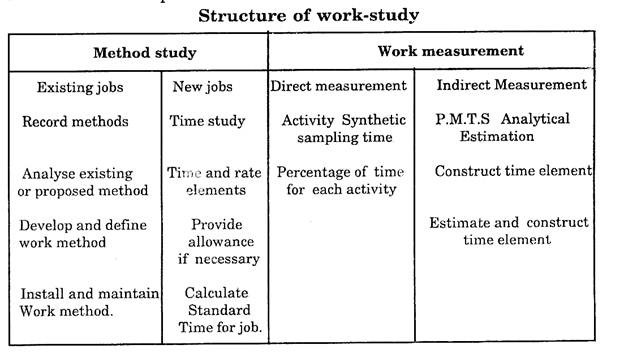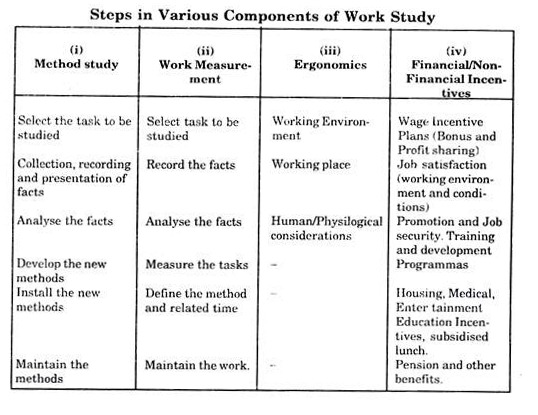Read this essay to learn about:- 1. Meaning of Work Study 2. Definitions of Work Study 3. Objectives 4. Importance 5. Components 6. Situations 7. Determination of Utility of Techniques.
Essay # 1. Meaning of Work Study:
Work-study is a management tool to achieve higher productive efficiency of an organization. It is concerned primarily with human manual work, more efficiently with the efficient design of such work and with the establishments of standards of performance.
An industrial enterprise, if it is to survive must use latest technology and most efficient methods improvised with a consistent aim of producing better quality goods at lower prices.
One way to improve the performance of production process is efficient utilization of plant, equipment and labor. This can be done by studying the work methods and evaluating their performance. Work- study is simply the study of work. It is the analysis of work dividing it into smaller parts followed by rearrangement of these parts to give the same effectiveness at lesser cost.
It examines both the method and duration of the work involved in a process.
Essay # 2. Definitions of Work Study:
In 1825 Robert Owen expressed that from management viewpoint any population along with the mechanism and other parts of an organization should be taken as a system composed of many parts which should be combined in such a way, that every hand, as well as every spring, lever and wheel should effectively co-operate to produce maximum pecuniary gain to the proprietors
Taylor gave more importance to ‘Time factor’ in work, realizing that ‘Overall times’ for jobs were of little value as standards of performance, and that times for elements of jobs were appropriate, if methods were to be examined. His objective was to treat work and management in a scientific manner.
Gilbreth gave more emphasis on Methods of performing some job and was of the opinion that once optimum methods are established the time factor would look after itself.
He described manual work with the help of seventeen fundamental movements and developed principles of motion study by which optimum work methods can be developed. In Motion study the work is broken into a number of fundamental movements and by analysing these movements the best methods of doing a job can be developed.
Charles Bedeaux introduced the concept of rating to evaluate the discrepancy between observed/actual and standard times. He tried to evolve some system of time study by which work methods could be compared. Provisions for rest and relaxation allowances were also made in the study.
Later on using precision measurement and detailed analysis techniques, optimum work methods were developed with full utilization of resources, thus benefiting both the organization and the individual. Relationship in work has been a continuing trend since the introduction of scientific management. It is responsible for tremendous economic growth and increase in the standard of living.
The nature and object of work-study can be explained by various definitions given below:
(i) Work study/Time and Motion study is primarily concerned with discovering the best ways of doing jobs and with establishing standards based upon such methods.
(ii) ILO defines “work study” as the technique of method study and work measurement employed to ensure the best possible use of human and material resources in carrying out a specified activity.
(iii) Work study is to minimize costs either by designing work for higher productivity or by improving productivity in existing work through improvements in current methods and by reducing ineffective or waste of time.
Method study is normally conducted before work measurement:
(iv) Work Study is a management service based on those techniques, in particular method study and work measurement, which are used in the examination of human work in all its contexts and which lead to the systematic investigation of all the resources and factors which effect the efficiency and economy of the situation being reviewed, in order to effect improvement.
(v) Work Study may be defined as the analytic investigation of the methods, conditions and effectiveness of industrial work, and thereby the determination of the ways in which human efforts may most economically be applied.
(vi) The term work-study is use to embrace two distinct but interdependent groups of techniques: Methods study and Work measurement. Both these techniques are mutually supporting and should be applied in ordered sequence.
(vii) Work-study is a generic term used for those techniques which are used in the examination of human work in all its contexts.
Essay # 3. Objectives of Work-Study:
The prime function of a work-study department is to submit proposals and implement schemes to increase Productivity and reduce Waste.
It should be capable of:
(i) To recommend and implement the desired improvements in work methods by establishing the most economical way of doing the work.
(ii) Investigation and analysis of existing situation.
(iii) Examination of weakness if any in the production process.
(iv) Most effective use of the exiting or proposed plant.
(v) Efficient use of human efforts.
(vi) Ensure proper performance of those employed in the production process.
(vii) Measurement of work values.
(viii) To initiate and maintain incentive bonus schemes.
(ix) Setting standards for labor cost control documentation.
(x) To standardize the method, material and equipment used in the production process.
(xi) To determine the time required by an ideal (a qualified and properly trained) operator to perform the task at some desired level of performance.
Essay # 4. Importance of Work Study:
(i) It is a mean of raising productivity of a factory by reorganization of the work involving little or no capital expenditure on plant and equipment.
(ii) It is a systematic study where no factor of production is overlooked.
(iii) It is most accurate method of determining the standards of performance on which effective planning and control depends.
(iv) It results in savings and efficient use of resources by increasing out-put reducing scarp.
(v) Results in improved safety.
(vi) Reduction in training time.
(vii) It is a tool, which can be, applied everywhere.
Essay # 5. Components of Work Study:
The main branches of work study are:
(i) Method study,
(ii) Work measurement,
(iii) Ergonomics and
(iv) Job-Evaluation; Functional/Non-functional.
Method study is the Systematic Recording, Critical analysis, Development and implementation/installation of new methods to perform job to reduce costs etc. with regard to exiting/proposed jobs. It is some sort of MOTION STUDY.
Work Measurement is TIME STUDY, which determines the amount of time required to perform a job/task by a worker following a particular/prescribed method. It is a technique for recording the time and rates of working for the elements of specified job carried out under specific conditions and for analysis of the data so as to obtain the time necessary for carrying out the jobs at a defined level of performance is working at a standard pace and using some standard methods.
Ergonomics is the study of relationship between worker and his working environment. It tries to adjust the job process according to the worker taking care of physical and mental strains. The study of Ergonomics includes a mix of working environment, working place and human physiological considerations.
Job Evaluation is a systematic and analytical study of evaluating the work relation and values of different jobs to decide wage rates ensuring fairness to all job holders in the organization. Merit Rating is a process/technique for knowing how efficiently and effectively a job is being carried out by a worker.
It is designed to assess the merit of the person doing the job. It decides the reward an employee should get in addition to his/her wages depending upon individual merit.
Financial and non-financial incentives are used to stimulate/motivate people to improve their performance level. These schemes are designed to suit specific situations, environmental conditions etc. Financial incentives are part of total wages and provide extra pay for extra performance.
These introduce monetary differences with-in the job. Non-financial incentives include comfortable working environment and conditions; promotion and job security viz. training and development programmes, pension, promotion and job security, housing, medical, recreational, educational, incentives, subsidized lunch, transportation incentives etc.
Essay # 6. Situations where Work Study should be Used:
The technique of work-study is used to evaluate the performance of tasks in an enterprise and to determine the corresponding level of performance. It is mainly concerned with effort, time, material, equipment and space used by an effective management for obtaining its goal. It results in increased productivity, reduced costs, better use of resources etc.
The indicators for using work-study methods in a process can be:
(i) Delay in work,
(ii) Rejection of finished goods and
(ii) Low efficiency of production.
There can be very little benefit in applying work study methods when:
(i) There is little manual work in a job. Here the performance of machines etc., cannot be improved.
(ii) There is some manual work but it is of temporary nature or short lived.
Essay # 7. Determination of Utility of ‘Work-Study’ Techniques:
(i) Anticipated life of the job.
(ii) Whether manual work is a significant part of the job or not.
This can be indicated by:
(a) Wage rate for the job.
(b) Ratio of machine time to manual time in the work cycle.
(iii) Whether utilization of machine, tools, jigs etc. is dependent or work method.
(iv) Importance of job towards the output, profit margin etc.
(v) The existing job needs work study investigation if there is:
(a) Low machine utilization.
(b) Excessive Over-time/idle time
(c) Complaints from worker.
(d) Inadequate quality
(e) High scarp/wastage rate.

